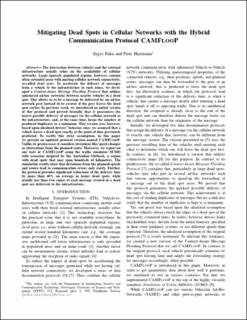| dc.contributor.author | Puka, Ergys | |
| dc.contributor.author | Herrmann, Peter | |
| dc.date.accessioned | 2022-11-23T07:34:42Z | |
| dc.date.available | 2022-11-23T07:34:42Z | |
| dc.date.created | 2022-03-30T17:21:50Z | |
| dc.date.issued | 2021 | |
| dc.identifier.isbn | 978-1-7281-9142-3 | |
| dc.identifier.uri | https://hdl.handle.net/11250/3033524 | |
| dc.description.abstract | The interaction between vehicles and the external infrastructure usually relies on the availability of cellular networks. Large sparsely populated regions, however, contain often extended areas with missing cellular network connectivity, so-called dead spots. To accelerate the delivery of messages from a vehicle to the infrastructure in such zones, we developed a Context-Aware Message Flooding Protocol that utilizes ephemeral ad-hoc networks between nearby vehicles in a dead spot. This allows us to let a message be delivered by an ad-hoc network peer instead of its creator if the peer leaves the dead spot earlier. In previous work, we introduced an initial version of this protocol and proved formally that it guarantees the fastest possible delivery of messages via the cellular network to the infrastructure, and, at the same time, keeps the number of produced duplicates to a minimum. This version was, however, based upon idealized drivers’ behavior since we assumed that a vehicle leaves a dead spot exactly at the point of time previously predicted. To rectify this strict assumption, in this paper we present an updated protocol version named CAMFLOOP. Unlike its predecessor, it considers deviations like speed changes or aberrations from the planned route. Moreover, we report on our tests of CAMFLOOP using the traffic simulator SUMO with scenarios inspired by the Australian Outback, a region with dead spots that may span hundreds of kilometers. The simulation results show that deviations from the planned speeds and routes lead to communication errors only rarely. Further, the protocol provides significant reductions of the delivery time by more than 40% on average in larger dead spots, while usually less than two copies of each message created in a dead spot are delivered to the infrastructure. | en_US |
| dc.language.iso | eng | en_US |
| dc.publisher | Institute of Electrical and Electronics Engineers (IEEE) | en_US |
| dc.relation.ispartof | 2021 IEEE International Intelligent Transportation Systems Conference (ITSC) | |
| dc.relation.uri | https://ieeexplore.ieee.org/document/9564660 | |
| dc.title | Mitigating Dead Spots in Cellular Networks with the Hybrid Communication Protocol CAMFLOOP | en_US |
| dc.type | Chapter | en_US |
| dc.description.version | acceptedVersion | en_US |
| dc.rights.holder | © IEEE. Personal use of this material is permitted. Permission from IEEE must be obtained for all other uses, in any current or future media, including reprinting/republishing this material for advertising or promotional purposes, creating new collective works, for resale or redistribution to servers or lists, or reuse of any copyrighted component of this work in other works. | en_US |
| dc.source.pagenumber | 1041-1048 | en_US |
| dc.identifier.doi | 10.1109/ITSC48978.2021.9564660 | |
| dc.identifier.cristin | 2013880 | |
| cristin.ispublished | true | |
| cristin.fulltext | postprint | |
| cristin.qualitycode | 1 | |
